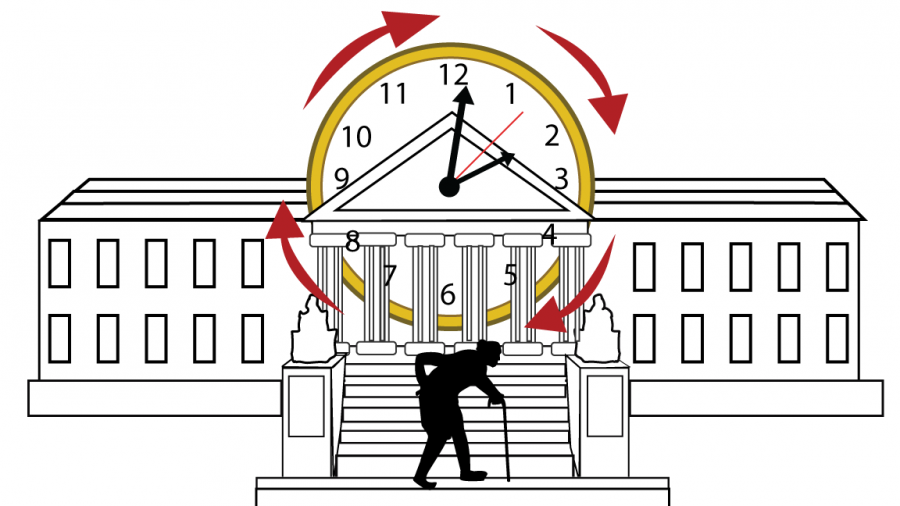OPINION: Motion to consider Supreme Court term limits
Photo credit/ Jennifer Flynn
September 10, 2020
The United States Supreme Court heads one of the three branches of our federal government, and arguably is the branch with the least checks and balances on its power. In the past 30 years or so, the idea of term limits for its justices has gone from a fringe pipe dream to actual policy platforms for presidential candidates.
In this current election cycle, Democratic candidate Andrew Yang favored Supreme Court term limits on his campaign website. Yang was one of three candidates who voted “yes” for term limits in a Washington Post survey of the 2020 Democratic candidates. As for the nominees this year, Kamala Harris responded that she was open to term limits while Joe Biden opposed the idea.
For once I agree with Yang. When the Framers created the Article in the Constitution about Supreme Court justices, no specific language was used to indicate a lifetime appointment. In their time, life expectancy was much lower than today, so appointing someone for life would be a much shorter term than it would be today. Today’s justices make decisions that will impact generations to come and with fewer appointments because of fewer vacancies, progress will come to a slow pace if not altogether halted. This is because of the fact that justices are unlikely to change their opinion on a similar issue being brought before them and it would take decades to undo a potentially bad ruling.
In 14% of decisions the Court makes, they are split 5-4, according to Protection on Government Oversight, and usually along partisan lines. Justice Ginsburg also said to expect more close rulings in the future, as reported by the Associated Press. Justices inevitably bring their own ideals to their decisions, which can negatively impact the country. Millions of lives depend on decisions by just nine people, all above the age of 50.
There are only two justices of color, and none are members of the LGBT community. Two sitting justices have had credible sexual misconduct allegations surface during their confirmation hearings, Justices Brett Kavanaugh and Clarence Thomas. The justices also make over $250,000 a year, making them ridiculously out of touch with the average middle-class American.
The politics of the Supreme Court are clear. The court is conservative by a slim margin, as the two appointments under President Donald Trump have swung the court considerably to the right. Many see Justice Ruth Bader Ginsburg as the last line of defense between a fully conservative court for decades to come. Ginsburg is nearing 90 and battling cancer. For liberals to put all of their eggs in her basket is unfair to her and to the rest of the country.
However, Justice Ginsberg could have saved us all from this conundrum by retiring around 2012 so that former President Barack Obama could nominate a younger liberal justice on the bench. Senate Majority Leader Mitch McConnell wouldn’t have been able to block that nomination like he did Judge Merrick Garland, right?
Again, I agree with Yang. Yang’s campaign website called for a Constitutional amendment with 18-year term limits for justices. His plan was to stagger the terms so that each president was allowed two appointments so that no more than one term limit reached in a given amount of time to allow for the appointment of a successor. A president could also defer an appointment if it came to an election year and the idea of nominating a justice then was politically hazardous. While this isn’t foolproof, it’s definitely a start in the right direction.
One argument against term limits comes from the R Street Institute, a conservative-leaning think tank. Their viewpoint is related to the human and political nature that comes with being a justice on the highest court in the nation or the person who appoints them. The argument is simple: justices can still strategically retire, or the Senate could refuse to confirm a nominee, resulting in a higher politicization of the court and therefore its justices. For example, a president could potentially nominate up to five justices in his or her eight years in office, which would constitute a majority for the court.
Another argument by R Street against term limits is that it would further politicize and polarize the courts, as who the next president would appoint would be a hot-button issue each election cycle. This happens now. R Street itself confirms this, using the 2016 campaign as an example, when then-candidates Trump and Hillary Clinton promised to appoint justices to overturn Roe v. Wade and Citizens United, respectively.
There needs to be some reform with the Supreme Court term limits as well as its lack of diversity in justices. A group pushing for term limits, Fix the Court, proposes that once the justices’ terms are up, they will still be paid like a pension from another job. They can do what federal judges do after retirement, such as fill in vacancies when needed or take a high circuit judicial job if they would prefer. While there are still specifics to be hammered out with the idea to make it as smooth a transition as possible, one thing is crystal clear: the need for term limits to allow for true justice to be served under the Supreme Court.
Contact the writer: [email protected]















